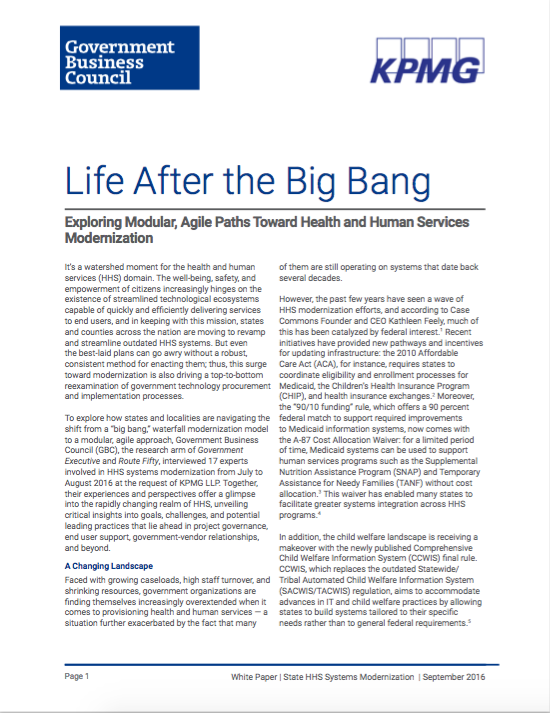
Life After the Big Bang
Exploring Modular, Agile Paths Toward Health and Human Services Modernization
It’s a watershed moment for the health and human services (HHS) domain. The well-being, safety, and empowerment of citizens increasingly hinges on the existence of streamlined technological ecosystems capable of quickly and efficiently delivering services to end users, and in keeping with this mission, states and counties across the nation are moving to revamp and streamline outdated HHS systems. But even the best-laid plans can go awry without a robust, consistent method for enacting them; thus, this surge toward modernization is also driving a top-to-bottom reexamination of government technology procurement and implementation processes.
To explore how states and localities are navigating the shift from a “big bang,” waterfall modernization model to a modular, agile approach, Government Business Council (GBC), the research arm of Government Executive and Route Fifty, interviewed 17 experts involved in HHS systems modernization from July to August 2016 at the request of KPMG LLP. Together, their experiences and perspectives offer a glimpse into the rapidly changing realm of HHS, unveiling critical insights into goals, challenges, and potential leading practices that lie ahead in project governance, end user support, government-vendor relationships, and beyond.

A Changing Landscape
Faced with growing caseloads, high staff turnover, and shrinking resources, government organizations are finding themselves increasingly overextended when it comes to provisioning health and human services — a situation further exacerbated by the fact that many of them are still operating on systems that date back several decades.
However, the past few years have seen a wave of HHS modernization initiatives, and according to Case Commons Founder and CEO Kathleen Feely, much of this has been catalyzed by federal interest. Recent initiatives have provided new pathways and incentives for updating infrastructure: the 2010 Affordable Care Act (ACA), for instance, requires states to coordinate eligibility and enrollment processes for Medicaid, the Children’s Health Insurance Program (CHIP), and health insurance exchanges. Moreover, the “90/10 funding” rule, which offers a 90 percent federal match to support required improvements to Medicaid information systems, now comes with the A-87 Cost Allocation Waiver: for a limited period of time, Medicaid systems can be used to support human services programs such as the Supplemental Nutrition Assistance Program (SNAP) and Temporary Assistance for Needy Families (TANF) without cost allocation. This waiver has enabled many states to facilitate greater systems integration across HHS programs.
In addition, the child welfare landscape is receiving a makeover with the newly published Comprehensive Child Welfare Information System (CCWIS) final rule. CCWIS, which replaces the outdated Statewide/Tribal Automated Child Welfare Information System (SACWIS/TACWIS) regulation, aims to accommodate advances in IT and child welfare practices by allowing states to build systems tailored to their specific needs rather than to general federal requirements. According to Feely, CCWIS has the potential to substantially promote innovation: “It frames the question around what states are allowed to do rather than what they’re required to do — an important distinction.”
Finally, all of these formal drivers are occurring in the context of an overarching cultural shift toward innovation: federal agencies such as the Administration for Children and Families (ACF) are increasingly engaging with the U.S. Digital Service (USDS), the General Services Administration’s (GSA) 18F, and other digital services groups to harness new technologies and apply leading practices on modernization.

The Evolution of Health and Human Services
Put yourself in this situation for a minute: you’re a single mother with a history of family trauma struggling to provide for yourself and your child. Things aren’t getting better, and you seek help from a gamut of health and human services programs. However, rather than receiving coordinated support from different programs, you’re forced to visit multiple public assistance offices, repeatedly provide your information and recite the details of your story, and work with a host of caseworkers and staff, all of whom operate in a vacuum rather than pooling their efforts. It’s a chaotic and inefficient process — one that leaves you frustrated, confused, and potentially more vulnerable than when you first started the process.
According to Jonathan Walters, senior editor at Governing magazine, stories like these are typical in the HHS domain. Many states have historically engaged in siloed development of HHS processes and administrative systems, and as a result, “Caseworker Jill can’t access caseworker Joe’s files to see if there’s any sort of crossover.” This holds enormous implications for HHS agencies, where a sizable percentage of clients are using multiple services across the enterprise: the single mother in the scenario above, for instance, might be eligible for income assistance, child support, mental health services, housing, and domestic violence resources. Even on a county level, this inability to achieve a 360-degree view of clients is a primary roadblock to addressing citizen needs. As Uma Ahluwalia, Director of Montgomery County, Maryland’s HHS Department, points out, “We serve about 120,000 clients a year, and more than a third of them are using more than two services across the department. It’s a complicated menu, and if we don’t have any way of determining what their needs are across the board, then we cannot prevent them from penetrating deeper into the system.”
None of this is news to states. According to Alisha Griffin, Director of California’s Department of Child Support Services (DCSS), breaking down silos and promoting service integration and interoperability has been an organizational priority for the last several decades: “People don't want to come into a lobby, people don't want to spend a day in court — people want access.” However, the confluence of federal encouragement and transformational, web-based technologies has opened new opportunities for states to really deliver results. The ACF’s interoperability initiative, for instance, provides resources to assist organizations in the planning and implementation of flexible, interoperable systems and services; this entails, among other things, the creation of a new Division of Data and Improvement, which promotes HHS-wide data interoperability and analysis efforts. Meanwhile, new tools like Case Commons’s social networking-driven Casebook are helping to streamline data collection and case management. Griffin notes that much of the driving force behind integration is going to come from the newest generation of government employees: “Millennials who’ve grown up with these new technologies are not going to sit still. They’re going to push us tremendously to break away from the traditional mold of delivering services.” This push for streamlined solutions is also manifesting itself in greater prioritization of mobility: employees at the Massachusetts Department of Children and Families (DCF), for instance, will be able to access a large portion of enterprise applications using any mobile device of their choice.
Millennials who’ve grown up with these new technologies are not going to sit still. They’re going to push us tremendously to break away from the traditional mold of delivering services.Alisha Griffin, Director of California Department of Child Support Services (DCSS)
All of this comes down to a fundamental reorientation of priorities. Professor Stephen Goldsmith of Harvard’s Ash Center for Democratic Governance and Innovation notes that many HHS systems have been designed as top-down accountability and processing systems: “They not only lack the ability to keep up with current technologies, but they also don’t focus on the unit of analysis they should have started with: helping the person in the field do their job better.” In order to craft useful, sustainable HHS systems, organizations need to think first and foremost about meeting the needs of end-users: on the caseworker side, designing intuitive processes that allow for greater mobility, automation, and information sharing; and on the client side, ensuring an integrated customer experience. This pursuit of integration is what Greg Kunz, Deputy Administrator at the Idaho Department of Health and Welfare (IDHW), considers to be a critical step toward clearing the clutter: “Everyone is trying to enhance customer service, and it’s become such a fuzzy, meaningless concept. It’s more about creating an experience for the customer where the confusion of all the different agencies and their individual decisions and verification methods are seen not as 15 different siloed processes, but as a common experience.”

Revisiting the Big Bang Theory
So how are organizations tackling the challenge of HHS systems modernization? Several years ago, the answer would have been straightforward: government has traditionally adhered to a “big bang” theory of systems development. This entails a sequential process for completing projects:
1) Identification of requirements
2) Procurement
3) Design and development
4) Testing
5) Implementation and deployment of a single system
6) Maintenance and operations
However, as many organizations have discovered, this monolithic, waterfall approach can be cumbersome in practice. A Request for Proposal (RFP) based on monolithic principles often translates into states investing hundreds of millions of dollars in a complex, multi-year process that frequently leaves projects over budget and behind schedule. And, as Fernando Muñiz, Deputy Commissioner of the Connecticut Department of Children and Families (DCF), points out, a lot can change in the years it takes to roll out a completed IT project: “If you’re undergoing design, development, and implementation phases that last three or four years, by the time you flip the switch on a system, some of the underlying technology and policy it was built around will already be outdated. The system is obsolete the moment it is delivered.” Furthermore, the monolithic approach often fails to integrate opportunities for reuse of both a state’s existing assets as well as assets from other states. It’s a wrinkle that the big bang approach isn’t well-equipped to address — the cohesiveness of a monolithic system, while ostensibly an advantage, can also make it difficult to implement changes and updates to tightly interwoven components.
In addition to being costly and slow to deliver value to customers, a monolithic process that aims to completely replatform legacy systems is often overly ambitious. Dan Hon, Digital Transformation Consultant at California’s Department of Technology, notes, “When you’re replacing a system that’s 10 or 15 years old, there’s a very high temptation to justify the RFP by throwing everything in the kitchen sink — and ultimately, that’s a lot to ask of one thing.” These vague, disparate specifications can ultimately result in a half-baked, bloated RFP.
For Hon, and for many other state experts, the endemic risks attached to monolithic systems are unacceptable when it comes to something as critical and dynamic as HHS delivery. The question, then, is how states are currently reconceptualizing their IT development paradigm.
If you’re undergoing design, development, and implementation phases that last three or four years, by the time you flip the switch on a system, some of the underlying technology and policy it was built around will already be outdated. The system is obsolete the moment it is delivered.Fernando Muñiz, Deputy Commissioner of Connecticut Department of Children and Families (DCF)

A New Path Toward Modernization
If there’s one key lesson organizations have drawn from the waterfall approach, it’s this: massive, complex undertakings can often be in danger of collapsing under their own weight. Thus, it’s not surprising that states and localities, backed by supporting guidance from the White House, USDS, and other federal entities, have begun to explore leaner, more flexible paths toward modernization.
One such route is agile, modular procurement and development approaches. In contrast to the linear big bang method, these processes seek primarily to break large projects down into smaller, more manageable increments. Through conversations with experts, GBC found that many states aiming for HHS systems transformation are aided by the tighter, faster release cycles associated with modular development. When the ACA was passed, for example, the Wyoming Department of Health (WDH) had to factor dramatic program changes and a shortened schedule into the planned implementation of its new eligibility system — a daunting undertaking in light of budget cuts and staff reductions. However, says Eligibility & Operations Administrator Jan Stall, by opting for a modular approach rather than attempting to stand up the entire system at once, Wyoming has been able to successfully implement the system and deliver value in smaller, more cost-effective phases.
Organizations that opt for a modular model are also likely to adopt agile principles. A proven success in the private sector, the agile framework — characterized by iterative development, rapid sprint cycles, and continuous, user-tested adjustments — is beginning to make its way into government technology. In particular, agile’s core ingredients of continuous delivery and enhancement of services holds tremendous appeal for many public sector leaders; Marc Slager, IT Director of Florida’s Department of Children and Families (DCF), is eager for his state to switch over to this development strategy in light of demonstrated inefficiencies with the monolithic model: “I do think smaller, faster turnaround of functionality that’s user-centric and aimed at good data will snowball in its positive effect: win after win after win, rather than the traditional monster product with mixed feedback.” Furthermore, some states such as California are experimenting with agile procurement: awarding multiple lower-priced contracts for separate modules, each of which can be completed in a relatively short period of time.
Of course, an agile, modular approach comes with its own set of challenges and considerations, particularly when it comes to adapting these principles to the procurement process.
Project Management and Governance
While the incremental development style of a modular, agile approach ensures regular product rollouts and upgrades, organizations still need to ensure that all these separate phases ultimately cohere into a single functional system. According to Kunz, establishing an overarching vision of what the final product is intended to do is one of the most critical components of agile HHS modernization — and it’s also something many organizations struggle to achieve. Accustomed to thinking of technology as a magic bullet, states frequently fall into the trap of applying IT to organizational problems without first engaging in thorough analysis — a lack of strategy that more often than not leads to ineffectual, poorly conceived IT environments and processes. Idaho, says Kunz, views technology’s role through a different lens. Rather than treating IT procurement as the initial step of the modernization process, the IDHW looks at systems development through a “problem-first mentality”: pinpointing existing issues, crafting appropriate solutions and a long-range roadmap for addressing these gaps, and only then progressing to the IT procurement and development phases.
Effective utilization of the agile methodology, then, depends on the ability of project management and governance structures to facilitate close collaboration across multiple organization groups. Specifically, says Griffin, business, IT, and policy priorities need to feed into each other rather than operating in vacuums: “Stakeholders on the business side tend not to understand things on the technology side, and vice versa. We need to figure out better ways to bring both to the table and ensure that all priorities are communicated and incorporated into the mission.” In addition to keeping project teams on track, consistent prioritization of mission objectives is integral toward helping organizations navigate external expectations. Agile sprint cycles may not in themselves produce usable new functionality and can thus be difficult to justify to legislators, who expect implementations to result in visible, immediate change. Robust governance and conveyance of goals can play a critical role in mitigating these political risks.
The challenge that lies ahead for many organizations is determining how best to equip offices to manage the complexities of multi-step modules. New Jersey’s Office of Information Technology (OIT) recently started a workgroup composed of IT project management officers, all of whom meet once a month to share tools and best practices. For its part, the California DCSS executive team meets every two weeks and devotes a full hour to governance: the Enterprise Project Management Director comes in, lines of communication are opened to all 58 counties, and participants are updated on ongoing projects, priorities, deficiencies, and requests for changes. “If you’re in governance,” maintains Griffin, “You can’t be at arm’s length from any technology development area: you have to own it. Governance needs to be transparent, regular, and all-inclusive — and you need to commit to it.”
“Stakeholders on the business side tend not to understand things on the technology side, and vice versa. We need to figure out better ways to bring both to the table and ensure that all priorities are communicated and incorporated into the mission.”Alisha Griffin, Director of California DCSS
End User Feedback
Here’s the underlying principle of systems modernization: every process designed, every solution implemented, must ultimately be for the benefit of the end user. It’s a tenet that many HHS experts, including Muñiz, take to heart: “We have a vision for something intuitive and web-based that works in tandem with our end users’ personal lives — where the interface is so self-explanatory that it doesn’t require a lot of training. We want to ensure continuous quality for our social workers so that they can do their best work for the families that deserve it.” It’s a worthy target — so how should organizations go about collecting and implementing essential end user feedback?
Many states have channels whereby end users can submit comments: in Maine’s Department of Health and Human Services (MHHS), for instance, frontline staff and managers can provide continuous feedback on obstacles to operational effectiveness. Users can also call into an internal help desk, leaving a database of problems that the organization can refer to and address. In addition, some states also seek feedback on beta processes and systems, some of which can lead to surprising insights: end users commenting on the Connecticut DCF’s modernization effort, for example, expressed dissatisfaction with the workaround created for the state’s legacy child welfare system. At the same time, they were reluctant to part with this inefficient workaround: these processes, limited as they were, were all that end users had ever known.
Other HHS leaders also comment on this paradox: “If you’d asked people what they wanted in a music player before MP3s were invented,” observes Kunz, “they would have requested a phonograph player with a longer extension cord.” In the same way, end users accustomed to working with an existing system will generally ask for improvements on that framework rather than offering suggestions for fundamentally different tools and solutions. Thus, while collecting feedback from staff is an integral part of the modernization process, Kunz qualifies that it’s important not just to ask questions, but to ask the right questions: rather than simply gathering general comments, states should be pitching new ideas to end users and obtaining targeted suggestions on potential improvements or issues.
If you’d asked people what they wanted in a music player before MP3s were invented, they would have requested a phonograph player with a longer extension cord.Greg Kunz, Deputy Administrator of Idaho Department of Health and Welfare (IDHW)
Finally, organizations need to bear in mind that end users are generally caseworkers with full-time jobs. This means that recruiting them to aid in the development process may prove difficult; as Scott Rogillio, Director of Application Development and Maintenance at Texas’s Department of Family and Protective Services (DFPS), observes of his state’s modernization effort: “[Getting user feedback] is always a challenge. To build a system right, you need input from the business units. However, everyone has their day job, and I don’t think they fully realized the level of commitment they were going to have to bring in. They’ve done it, but there’s been some initial grumbling.”
Change Management
When it comes to systems modernization, addressing technological needs is only half the battle. The period both before and after systems deployment is critical: organizations need to formulate a cohesive strategy for managing and communicating the change effort. All stakeholders need to be provided with extensive support and monitoring to help ensure successful acclimation to the new framework; as Slager notes, “You might have a great information system, but that doesn’t mean your people know or even care how to use it.” Adjustment gaps between older and younger employees are particularly noticeable — a divide that organizations must take care to bridge with the implementation of new technologies.
These growing pains can be mitigated by expanded resources. Take Massachusetts, for example — at their DCF, employees can contact IT personnel and mobile technicians staffing a central helpdesk with any questions about new interfaces. In addition, California’s DCSS is transitioning away from traditional classroom training in favor of providing staff with expanded e-learning opportunities. Says Griffin, “If all the training is held in a classroom, then a lot of counties will go untrained because you can only send so many people to one training session. An e-learning environment is more accessible and allows us do a whole lot more.”
Government-Vendor Relationships
The shift toward modular, agile principles promises substantial changes in government-vendor relationships. Under the waterfall approach, organizations typically work with one system integrator (SI) throughout the modernization process. In contrast, incremental development calls for breaking large monolithic systems down into capabilities that can be replaced in an iterative or phased way. Many experts, such as Rogillio, believe that this empowers organizations to select the most qualified contractor for each module: “We’re able to award a contract to a vendor that really specializes in that field — if, for instance, we wanted to pursue a mobile RFP, we wouldn’t expect a legacy conversion vendor to bid on that. With a modular approach, we’re able to distribute the wealth amongst the best players in each of the technology stacks.” In addition, the shorter development and delivery cycles attached to small RFPs allow states to retain key vendor personnel for the duration of the project. This is less likely with monolithic projects, which are often subject to schedule overruns: vendors have a limited staffing bench and, as a result, may transition their most experienced and talented personnel away from a prolonged project and onto a new RFP.
However, some point out that breaking the procurement process into multiple pieces, while sound in theory, may not be successful in a system that has proven ill-prepared to handle procurement requests: “What may be a software engineer’s theoretically ideal approach...may well fail to take into consideration, much less prepare for, the current antiquated procurement process that for better or worse provides the institutional foundation for federal and state funding and support.” Furthermore, in completing individual modules as opposed to overseeing one gargantuan system, vendors may fail to grasp or lose sight of the project’s overarching vision. Thus, David Simsarian, Director of Business Technology Solutions at Maine’s Department of Health and Human Services (HHS), notes that it is essential for states to consistently communicate goals, priorities, and details to SIs — the vendors working for Maine’s HHS Department, for example, are “clear on the mission because we’re clear on it from the beginning with them. They can see where their contribution is fitting into the larger program.” And in order to keep vendors on track, says Hon, states pursuing agile development need to take on some of the technical expertise that traditionally falls to SIs: “The explicit intention is that there has to be knowledge transfer — this isn’t going to continue to be a situation where the vendor has more knowledge about the architecture of the technology system than the state does.”
While the shift to a modular, agile framework has proven jarring for vendors accustomed to the big bang approach, Griffin believes the transition is actually allowing vendors to more effectively manage and work with the resources they have. And, she adds, it’s opened up new contracting opportunities for SIs: “These days, I find that there’s a lot more interest in vendors and a lot more people in the space.”

Reconceptualizing Modernization in California
Early last year, the California Department of Social Services (CDSS) invited Code for America (CfA) to review its draft RFP for an updated child welfare system — a simple request that would catalyze an unprecedented transformation in the state’s procurement and development processes.
“It was a very complicated, very large RFP,” notes Dan Hon, who at the time served as CfA’s Editorial Director, “And what I saw was no real indication that there would be a marked improvement to the child welfare infrastructure if it went forward.” The draft RFP, which was based on a traditional waterfall model, would have resulted in a half-billion-dollar procurement with a rollout date of 2020 or 2021 at the earliest. To its credit, Hon says, California recognized that the monolithic RFP carried an unacceptable degree of risk for a system that serves nearly 100,000 children across the state. Thus, aided by CfA and other groups, CDSS is currently embarking on a large-scale effort to modernize its child welfare services according to agile, modular principles.
This new approach bears several distinctions. First, the introduction of smaller modules, each with its own separate set of requirements, requires California to seek out and assess different types of vendor competencies. In order to facilitate this process, the state has introduced an agile development pre-qualified (ADPQ) vendor pool. This pool is determined through two pre-screening processes: technical and user-centered. Contractors that successfully demonstrate both technical and user design expertise will be added to a shortlist of pre-approved vendors. The ADPQ pool, which will be refreshed every six months, is intended to expedite the procurement process and encourage a competitive vendor landscape. Hon feels that the latter is healthy from the state’s perspective: “It incentivizes vendors to bring skills to the table that might otherwise have been obscured behind a traditional SI model.”
CDSS is seeking to extensively embed end users into the ADPQ vendor vetting process: the state is recruiting social workers to test out vendors’ submitted services for the user experience screening portion. End user feedback is also expected to play an integral role after the contract bidding process: end users from six core counties will be assigned to the intake module’s development team, where they will participate in the actual specification and testing of the service.
Of course, this plan rests on the state’s ability to successfully find end users willing to commit an ample amount of time to development team responsibilities. Some in the HHS field have also pointed out that California’s approach relies heavily on input from CfA, 18F, and other digital services groups. These organizations often have a distinctly private sector-informed perspective, and many fear that the IT practices they outline may not necessarily work as well at the state level: project management experts, for instance, highlight reluctance from elected officials to back a project with fluid, fluctuable scope and cost expectations. These are salient concerns in light of issues that have arisen under this new model: while the project is moving forward, the state’s first round of procurements has been confronted with schedule delays.
It remains to be seen how these potential hurdles, and more, will be addressed by California as it continues to navigate the path toward agile child welfare modernization.

Empowering HHS in Utah
For Utah’s Department of Workforce Services (DWS), the passage of the ACA prompted some dramatic restructuring: in order to implement the new Modified Adjusted Gross Income (MAGI) methodology, DWS had to rewrite its entire rules engine for Medicaid eligibility and enrollment. However, Utah didn’t stop there. In order to extend integration across the HHS enterprise, DWS took advantage of the 90/10 funding A-87 cost allocation waiver to rewrite the rules for non-Medicaid programs as well: SNAP, TANF, child care services, and other human services across the board. According to DWS Assistant Director Kevin Burt, the goal wasn’t simply to reach basic ACA compliance: “We wanted to maintain integration — an integrated system has incredible value, and Utah would never promote anything else.”
However, while integration is a chief priority, it isn’t always easy to achieve. According to Burt, different policies within an integrated system are often misaligned — the MAGI methodology outlined by the ACA, for instance, is singular to Medicaid and doesn’t apply to any other DWS program. These discrepancies introduce a great deal of complexity into the system, opening the potential for critical errors. The key to mitigating this confusion, says Burt, is to bring together the policy, business, and IT sides of an organization during the implementation of a project. Rather than allowing these three elements to operate in silos, DWS has physically co-located them within the organization in order to ensure cross-verification of processes and policies. This cohesion of business, policy, and IT didn’t exist under Utah’s previous waterfall development model; however, the state’s shift to an agile, modular approach has encouraged greater coordination among all three branches. The benefit of this approach, says Burt, is that throughout the lifecycle of the project, all three continuously challenge and refine one another. As a result, the end product of agile development isn’t just IT — it’s clean policy and clear processes.
In addition to facilitating business, IT, and policy coordination, the agile methodology is also helping to smooth the HHS modernization process for DWS. Burt points out that while a monolithic system overhaul is possible, it results in a more difficult transition for end users. Instead, Utah’s goal is to continually modernize and update an existing system: “To a worker, it seems like the same system is always functioning in place, but the actual guts of that system will be completely different.”
And all of these components — clear policies, a stable business model, and consistent performance — will ultimately allow Utah to aim for even greater capacities in HHS provision. While DWS’s current prerogative is to provide benefits, Burt envisions something even bigger: “We’ve started not just providing citizens with the services they’re eligible for, but connecting them with resources that will enable them to move beyond needing these benefits in the first place.” Empowering citizens to stand on their own — that’s perhaps the ultimate objective of HHS, and one that Utah is determined to achieve.
We’ve started not just providing citizens with the services they’re eligible for, but connecting them with resources that will enable them to move beyond needing these benefits in the first place.Kevin Burt, Assistant Director of Utah Department of Workforce Services (DWS)

Transforming Child Welfare in Texas
Every massive venture is comprised of a multitude of smaller steps — and Texas’s Department of Family and Protective Services (DFPS) is putting that philosophy into practice. In embarking on its child welfare system modernization at the end of 2012, Texas chose to split the process into smaller, more manageable increments. Previous experience had taught the organization that it was better at handling contracts in the 2 to 3 million dollar range, and, as DFPS Director of Application Development and Maintenance Scott Rogillio puts it, “We didn’t want to put all of our eggs in one basket and then have the entire contract go south if anything went wrong.” In addition, Texas provides funding in biennially; DFPS therefore needed to demonstrate substantial progress to the legislature in the first 2 years of the project in order to continue to receive funding. Smaller contracts, explains Rogillio, were more workable and would yield results more quickly: “We wanted to make sure we were internally ready to take on modernization, and the best way to do that was to start small. It was a ‘let’s walk before we start running’ mentality.”
To prepare for the endeavor, DFPS brought on both an independent verification and validation (IV&V) vendor and a project management office (PMO) to help evaluate and guide the process. DFPS then undertook its first modernization project: transforming its financial COBOL batch jobs to Java. This process, which took approximately a year, gave the organization a sense of what the rest of the transformation effort would entail. It was then able to apply these lessons to Phase 1 of its modernization effort, in which it streamlined four functional areas of its IMPACT system:
- Statewide Intake (SWI) Contact Center,
- eReports,
- Automated Background Check Processing, and
- External Access to limited IMPACT case data for CASA volunteers.
This step, says Rogillio, was primarily designed to set the standards for the new technology stack: “For Phase 1, we wanted the contractor to build out the entire framework; we needed somebody to build the standards and demonstrate workability by bringing in intake and new reports.” Future contracts will work within the architecture delivered in Phase 1, thus ensuring that all future processes and technologies align to the same set of standards. Maintaining this overarching coherence, Rogillio stresses, is essential to the success of the modular approach: “Modularity can’t be too grainy — there’s a fine line between being too granular and too large.”
We wanted to make sure we were internally ready to take on modernization, and the best way to do that was to start small. It was a ‘let’s walk before we start running’ mentality.Scott Rogillio, Director of Application Development and Maintenance at the Texas Department of Family and Protective Services (DFPS)
According to Rogillio, while the effort has led to tangible improvements thus far — the automation and integration of statewide intake processes will allow workers to save several minutes per intake — one of the more challenging aspects of modernization has been elucidating employees on the “art of the possible.” Employees accustomed to outdated tools often found it difficult to envision what new processes could bring to the table, and earning sufficient end user buy-in took several months of design sessions: “Imagine trying to describe an iPhone to someone in the ‘90s with a brick phone — it’s like, ‘What do you mean you can take pictures on a phone?’”
DFPS is currently undergoing procurement for Phase 2 of its IMPACT Modernization effort, which will incrementally build on Phase 1 and be designed to meeting new SACWIS requirements. This next phase will also place greater focus on another element of change management: end user training and support. Guiding the organization through change, says Rogillio, is one of the most crucial requirements for successfully modernizing: “We can build a great system, but it’s there’s no knowledge or training around it, if we don’t get an A+ on that, then the entire system is doomed.”

Conclusion
What is the definition of civilization? You could name a host of distinguishing traits: written language, technological innovation, governing bodies, division of labor, and beyond. But more than that, a civilized society may be best defined by its adherence to one simple, overarching principle: to protect all of its members, and to provide for those who are most in need.
This ethos resides in every aspect of HHS, and it is now being put to the test. In order to meet increasingly complex citizen needs, state and local HHS organizations need to rebuild their IT systems according to twenty-first century principles. The conversation surrounding this effort — the merits of an agile, modular modernization approach versus a traditional monolithic method — will ultimately dictate the success of this endeavor. In particular, organizations need to appreciate the challenges associated with:
- Procurement — understanding and being prepared to address potential incompatibilities between agile principles and current government procurement processes
- Project management and governance — developing a cohesive vision for modernization and facilitating close IT, policy, and business collaboration in order to bring that plan to fruition
- Incorporating end user feedback — garnering and incorporating practical, targeted stakeholder feedback throughout the design, development, and implementation phases
- Change management — devoting ongoing attention to preparing the organization for new processes and technologies
- Government-vendor relationships — maintaining clear, consistent communication between organizations and SIs throughout the procurement and development process to ensure the realization of mission priorities
This is an enormous undertaking, and one that will face significant obstacles in the years ahead. However, if there’s a single point of consensus to be found among the HHS experts interviewed by GBC, it’s this: there is nothing else they would rather be doing. As Slager puts it, “It’s unacceptable to remain 10 years behind the technology curve — not when there are children and families on the line. We can’t lose sight of that. They’re the whole reason we’re doing this.”

Research Methodology
GBC and KPMG LLP launched an in-depth qualitative research campaign in summer 2016. From July 7, 2016 to August 11, 2016, GBC conducted 30- to- 45-minute interviews with HHS systems modernization experts on topics such as HHS organizations’ modernization initiatives, systems development processes, and procurement methodologies. A total of 17 experts representing a range of federal, state, local, academic, and non-profit organizations and job functions were interviewed. The full list of interviewees is as follows:
- Tomy Abraham — Director of Business Applications, Massachusetts Department of Children and Families
- Uma Ahluwalia — Director, Montgomery County Department of Health and Human Services, Maryland
- Kevin Burt — Assistant Director, Utah Department of Workforce Services
- Kathleen Feely — Founder & CEO, Case Commons; Vice President for Innovation, Annie E. Casey Foundation
- Stephen Goldsmith — Daniel Paul Professor of the Practice of Government, Ash Center for Democratic Governance and Innovation, Harvard Kennedy School
- Alisha Griffin — Director, California Department of Child Support Services
- Dan Hon — Digital Transformation Consultant, California Department of Technology
- Greg Kunz — Deputy Administrator of the Division of Welfare, Idaho Department of Health and Welfare
- Fernando Muñiz — Deputy Commissioner, Connecticut Department of Children and Families
- Scott Rogillio — Director of Application Development and Maintenance, Texas Department of Family and Protective Services
- David Simsarian — Director of Business Technology Solutions, Maine Department of Health and Human Services
- Marc Slager — IT Director, Florida Department of Children and Families
- Jan Stall — Eligibility & Operations Administrator of the Division of Healthcare Financing, Wyoming Department of Health
- Chris Traver — Senior Advisor for Information Sharing, Administration for Children and Families, U.S. Department of Health and Human Services
- Jonathan Walters — Senior Editor, Governing magazine
In addition, GBC interviewed two HHS experts who have chosen to remain anonymous.
About GBC
As Government Executive Media Group's research division, Government Business Council (GBC) is dedicated to advancing the business of government through analysis, insight, and analytical independence. An extension of Government Executive's 40 years of exemplary editorial standards and commitment to the highest ethical values, GBC studies influential decision makers from across the federal government to produce intelligence-based research and analysis.
Report author: Rina Li
About KPMG LLP
KPMG LLP leverages a global network of highly experienced health and human services professionals from across a wide range of functional and technical service areas to deliver tailored and practical solutions to our firm’s clients. Our teams have strong skills and deep knowledge in business transformation, harnessing data analytics, and implementing solutions to improve program outcomes. KPMG’s tools include the KPMG Enterprise Reference Architecture for Health and Human Services, KPMG Resource Integration Suite, and KPMG Analytics Driving Insights. For more insights, visit www.kpmg.com/us/hhs.
